Solving Power Balance Problems in Single-Traction Tractors Using PTractor Plus 1.1, a Possible Learning Aid for Students of Agricultural Engineering
Abstract
1. Introduction
2. Materials and Methods
2.1. Start-Up Window
2.2. Soil Data
2.3. Data Pertaining to the Forward and Rear Wheels
2.4. Chassis and Engine Data
2.5. Main Window
2.6. Visualizing the Results
- (a)
- Press the CALCULATE button in the main window. A window will then appear with all the results.
- (b)
- Clicking on a result will cause a window to appear with the formula used to obtain that results. To move between the different types of result, the user need only click on the different tabs.
- (c)
- To return to the main window, the RETURN button is pushed.
2.7. Saving a Problem
2.8. Recovering a Saved Problem
2.9. Printing Results
2.10. Evaluation of the Software
3. Results and Discussion
4. Conclusions
Author Contributions
Funding
Acknowledgments
Conflicts of Interest
References
- Mercader, C.; Sallan, J.G. How do university teachers use digital technologies in class? Rev. Docencia Univ. 2017, 15, 257–273. [Google Scholar] [CrossRef]
- Palkova, Z.; Vakhtina, E. Innovative learning: From multimedia to virtual worlds. In Proceedings of the 7th International Conference on Education and New Learning Technologies (EDULEARN), Barcelona, Spain, 6–8 July 2015; Gomez-Chova, L., Lopez-Martinez, A., Candel-Torres, I., Eds.; IATED: Valencia, Spain, 2015. [Google Scholar]
- Busato, P.; Berruto, R.; Zazueta, F.S.; Silva-Lugo, J. Student performance in conventional and flipped classroom learning environments. Appl. Eng. Agric. 2016, 32, 509–518. [Google Scholar] [CrossRef]
- Katzis, K.; Dimopoulos, C.; Meletiou-Mavrotheris, M.; Lasica, I.E. Engineering Attractiveness in the European Educational Environment: Can Distance Education Approaches Make a Difference? Educ. Sci. 2018, 8, 16. [Google Scholar] [CrossRef]
- Babich, A.; Mavrommatis, K.T. Teaching of complex technological processes using simulations. Int. J. Eng. Educ. 2009, 25, 209–220. [Google Scholar]
- Sanchez, J.A.; Perez, N.; Rodriguez, F.; Guzman, J.L.; Lopez, J.C. Decision support system for controlling the growth of greenhouse pepper crops base on climatic conditions. In Proceedings of the 7th Iberian Congress of Agricultural Engineering and Horticultural Sciences, Madrid, Spain, 26–29 August 2013; Tellez, F.A., Rodriguez, A.M., Sancho, I.M., Robinson, M.V., RuizAltisent, M., Ballesteros, F.R., Hernando, E.C.C., Eds.; The Universidad Politécnica de Madrid: Madrid, Spain, 2014. [Google Scholar]
- Perez-Castro, A.; Sanchez-Molina, J.A.; Castilla, M.; Sanchez-Moreno, J.; Moreno-Ubeda, J.C.; Magan, J.J. FertigUAL: A fertigation management app for greenhouse vegetable crops. Agric. Water Manag. 2017, 183, 186–193. [Google Scholar] [CrossRef]
- Marti, P.; Royuela, A. Practical sesion on the application of a robust mathematical tool for the calculation of crop water requirements in agricultural engineering. In Proceedings of the 6th International Conference on Education, Research and Innovation (ICERI), Seville, Spain, 18–20 November 2013; Chova, L.G., Martinez, A.L., Torres, I.C., Eds.; IATED: Valencia, Spain, 2013. [Google Scholar]
- Molina, J.M.; Ruiz-Canales, A.; Jimenez, M.; Soto, F.; Fernandez-Pacheco, D.G. SCADA Platform Combined with a Scale Model of Trickle Irrigation System for Agricultural Engineering Education. Comput. Appl. Eng. Educ. 2014, 22, 463–473. [Google Scholar] [CrossRef]
- Ahmad, F.; Kumar, A.; Kanwar, K.; Patil, P.P. CFX, Static Structural Analysis of Tractor Exhaust System Based on FEA. In Proceedings of the 28th International Conference on CAD/CAM, Robotics and Factories of the Future (CARs and FoF), Kolaghat, India, 6–9 January 2016; Mandal, D.K., Syan, C.S., Eds.; Springer: New Delhi, India, 2016. [Google Scholar]
- Sancibrian, R.; Llata, J.R.; Sarabia, E.G.; Torre-Ferrero, C.; Blanco, J.M.; San-Jose, J.T. Industry of the future: Implementation of collaborative CAE tools in industrial engineering degrees. In Proceedings of the 11th International Conference on Technology, Educarion and Development (INTED), Valencia, Spain, 6–8 March 2017; Chova, L.G., Martinez, A.L., Torres, I.C., Eds.; IATED: Valencia, Spain, 2017. [Google Scholar]
- Hashemipour, M.; Manesh, H.F.; Bal, M. A modular virtual reality system for engineering laboratory education. Comput. Appl. Eng. Educ. 2011, 19, 305–314. [Google Scholar] [CrossRef]
- Potkonjak, V.; Gardner, M.; Callaghan, V.; Mattila, P.; Guetl, C.; Petrovic, V.M.; Jovanovic, K. Virtual laboratories for education in science, technology, and engineering: A review. Comput. Educ. 2016, 95, 309–327. [Google Scholar] [CrossRef]
- Reimann, P.; Bull, S.; Halb, W.; Johnson, M. Design of a computer-assisted assessment system for classroom formative assessment. In Proceedings of the 14th International conference on Interactive Collaborative Learning (ICL), Piestany, Slovakia, 21–23 September 2011. [Google Scholar]
- Reimann, P.; Kickmeier-Rust, M.; Albert, D. Problem solving learning environments and assessment: A knowledge space theory approach. Comput. Educ. 2013, 64, 183–193. [Google Scholar] [CrossRef]
- Fita, A.; Monserrat, J.F.; Molto, G.; Mestre, E.M.; Rodriguez-Burruezo, A. Use of Synchronous e-Learning at University Degrees. Comput. Appl. Eng. Educ. 2016, 24, 982–993. [Google Scholar] [CrossRef]
- Gilarranz, C.; Olivares, J.; Munoz, M.A.; Lazaro, J.M.; Ramos-Paul, P. Collaborative tutorial groups in virtual environments with Moodle as a support. In Proceedings of the 7th Iberian Congress of Agricultural Engineering and Horticultural Sciences, Madrid, Spain, 26–29 August 2013; Tellez, F.A., Rodriguez, A.M., Sancho, I.M., Robinson, M.V., RuitzAltisent, M., Ballesteros, F.R., Hernando, E.C.C., Eds.; The Universidad Politécnica de Madrid: Madrid, Spain, 2014. [Google Scholar]
- Lytridis, C.; Tsinakos, A.; Kazanidis, I. ARTutor—An Augmented Reality Platform for Interactive Distance Learning. Educ. Sci. 2018, 8, 6. [Google Scholar] [CrossRef]
- Wei, X.D.; Weng, D.D.; Liu, Y.; Wang, Y.T. Teaching based on augmented reality for a technical creative design course. Comput. Educ. 2015, 81, 221–234. [Google Scholar] [CrossRef]
- Fabregas, E.; Farias, G.; Dormido-Canto, S.; Esquembre, F. Developing a remote laboratory for engineering education. Comput. Educ. 2011, 57, 1686–1697. [Google Scholar] [CrossRef]
- Djouad, T.; Mille, A. Observing and Understanding an On-Line Learning Activity: A Model-Based Approach for Activity Indicator Engineering. Technol. Knowl. Learn. 2018, 23, 41–64. [Google Scholar] [CrossRef]
- Rio, C.J.; Pastor, M.E.M.; Calle, R.C.; Robaina, N.F. Academic Performance in Higher Education and its Association to Active Participation in the Moodle Platform. Estudios Sobre Educ. 2018, 34, 177–198. [Google Scholar] [CrossRef]
- Kic, P. The course transport, handling and manipulation machinery in engineering education. In Proceedings of the 13th International Scientific Conference on Engineering for Rural Development, Jelgava, Latvia, 29–30 May 2014; Osadcuks, V., Ed.; Latvia University of Agriculture: Jelgava, Latvia, 2014. [Google Scholar]
- Daroczi, M.; Toth, R.; Molnar, C. The influence of Information Technology on Agricultural Machinery. In Proceedings of the 7th International Scientific Conference on Managerial Trends in the Development of Enterprises in Globalization Era (ICoM), Nitra, Slovakia, 1–2 June 2017; Kosiciarova, I., Kadekova, Z., Eds.; Slovak University of Agriculture: Nitra, Slovak, 2017. [Google Scholar]
- Yin, C.Q.; Sun, Q.; Wu, J.; Liu, C.Q.; Gao, J. Development of Electrohydraulic Steering Control System for Tractor Automatic Navigation. J. Electr. Comput. Eng. 2018, 2018, 5617253. [Google Scholar] [CrossRef]
- Lee, D.H.; Kim, Y.J.; Choi, C.H.; Chung, S.O.; Inoue, E.; Okayasu, T. Development of a Parallel Hybrid System for Agricultural Tractors. J. Fac. Agric. Kyushu Univ. 2017, 62, 137–144. [Google Scholar]
- Sim, K.; Lee, H.; Yoon, J.W.; Choi, C.; Hwang, S.H. Effectiveness evaluation of hydro-pneumatic and semi-active cab suspensión for the improvement of ride confort of agricultural tractors. J. Terramechanics 2017, 69, 23–32. [Google Scholar] [CrossRef]
- Castagnetti, D.; Bertacchini, A.; Spaggiari, A.; Lesnjanin, A.; Larcher, L.; Dragoni, E.; Arduini, M. A novel ball joint wear sensor for low-cost structural health monitoring of off-highway vehicles. Mech. Ind. 2015, 16, 507. [Google Scholar] [CrossRef][Green Version]
- Rencin, L.; Polcar, A. Determination of the tractor engine power in the field conditions. In Proceedings of the 23rd International PhD Students Conference (MendelNet), Brno, Czech Republic, 9–10 November 2016; Polak, O., Cerkal, R., Belcredi, N.B., Horky, P., Vacek, P., Eds.; Mendel Univerzity in Brno: Brno, Czech Republic, 2016. [Google Scholar]
- De Farias, M.S.; Schlosser, J.F.; Estrada, J.S.; Frantz, U.G.; Rodriguez, F.A. Evaluation of new agricultural tractors engines by using a portable dynamometer. Cienc. Rural 2016, 46, 820–824. [Google Scholar] [CrossRef][Green Version]
- Pereira-Marin, C.A.; Perez-Mendez, A.; Marin-Darias, D.; Gonzalez-Cueto, O. ExploMaq, software for energetic and economic evaluating of farming machine. Rev. Cienc. Técnicas Agropecu. 2015, 24, 72–76. [Google Scholar]
- Santos, F.L.; de Queiroz, D.M. Simtrac-an application for simulation of traction efficiency of agricultural tractors with front wheel assist. Acta Sci.-Technol. 2016, 38, 423–430. [Google Scholar] [CrossRef]
- March-Andreu, V.; Lozano-Terrazas, J.L. Mecanización Agraria. Maquinaria Agrícola y forestal; Llorens: Valencia, Spain, 2014; p. 318. ISBN 978-84-616-8005-4. [Google Scholar]
- Callejon-Ferre, A.J.; Lopez-Martinez, J.A.; Lopez-Perez, A.I. Manual de Ejercicios y Cuestiones de Clase de la Asignatura de Motores y Máquinas Agrícolas Adaptado al Espacio Europeo de Educación Superior; Universidad de Almería: Almería, Spain, 2008; pp. 1–190. ISBN 978-84-691-8107-2. [Google Scholar]
- Matcho, J. Using Delphi 2, Special Edition ed; Prentice Hall: Bergen, NJ, USA, 1996. [Google Scholar]
- Evans, M.D.; Clark, R.L.; Manor, G. An improved traction model for ballast selection. Trans. ASAE 1991, 34, 773–780. [Google Scholar] [CrossRef]
- Shibusawa, S.; Sasao, A. Traction data analysis with the traction prediction equation. J. Terramechanics 1996, 33, 21–28. [Google Scholar] [CrossRef]
- Sharma, A.K.; Pandey, K.P. Traction data analysis in reference to a unique zero condition. J. Terramechanics 1998, 35, 179–188. [Google Scholar] [CrossRef]
- Raheman, H.; Jha, S.K. Wheel slip measurement in 2WD tractor. J. Terramechanics 2007, 44, 89–94. [Google Scholar] [CrossRef]
- Huang, Y.J.; Khajepour, A.; Zhu, T.J.; Ding, H.T. A Supervisory Energy-Saving Controller for a Novel Anti-Idling System of Service Vehicles. IEEE/ASME Trans. Mechatron. 2017, 22, 1037–1046. [Google Scholar] [CrossRef]
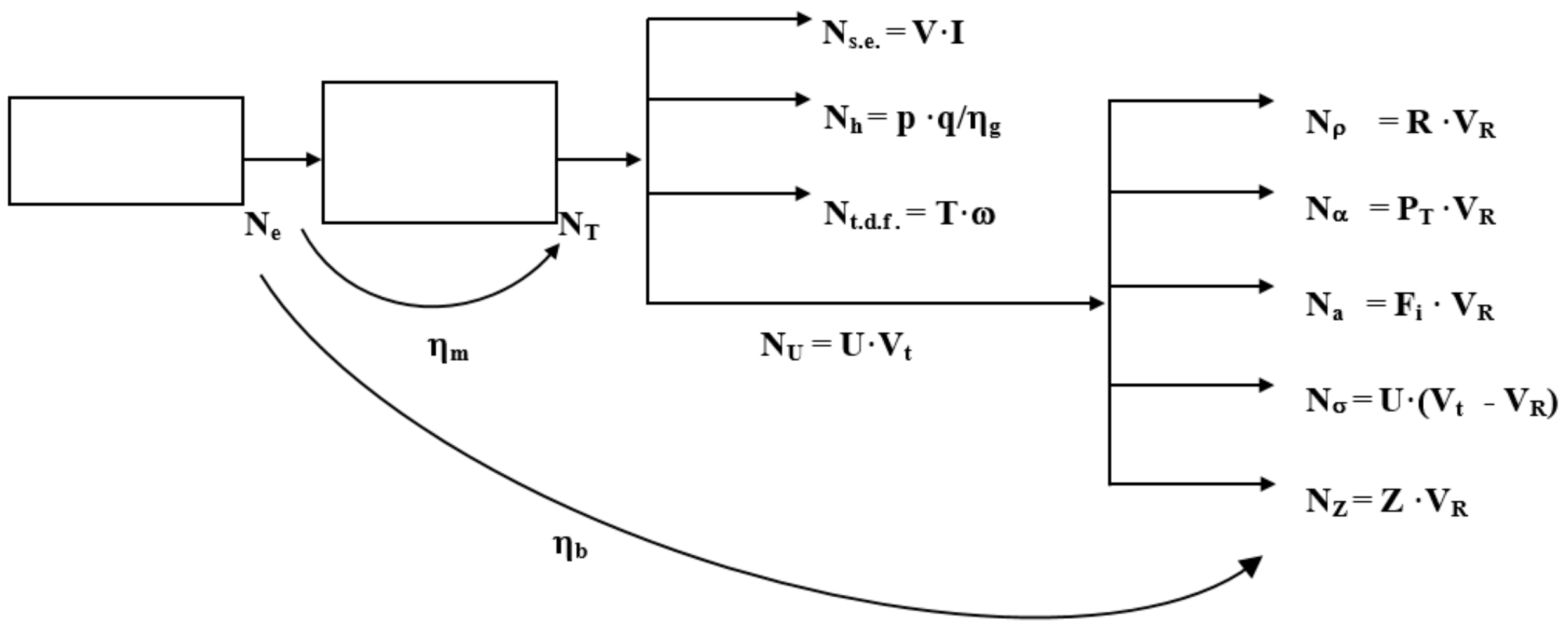
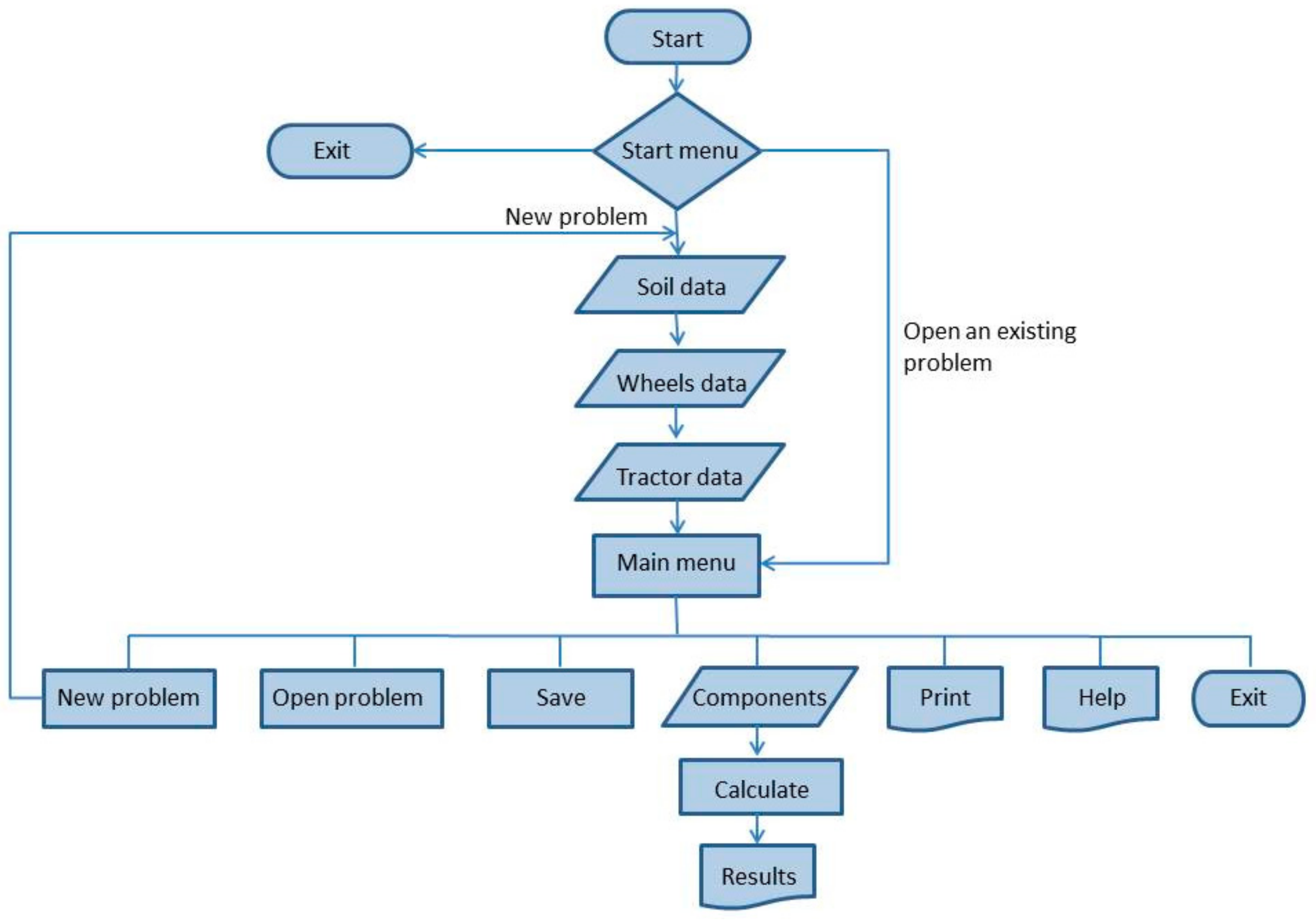
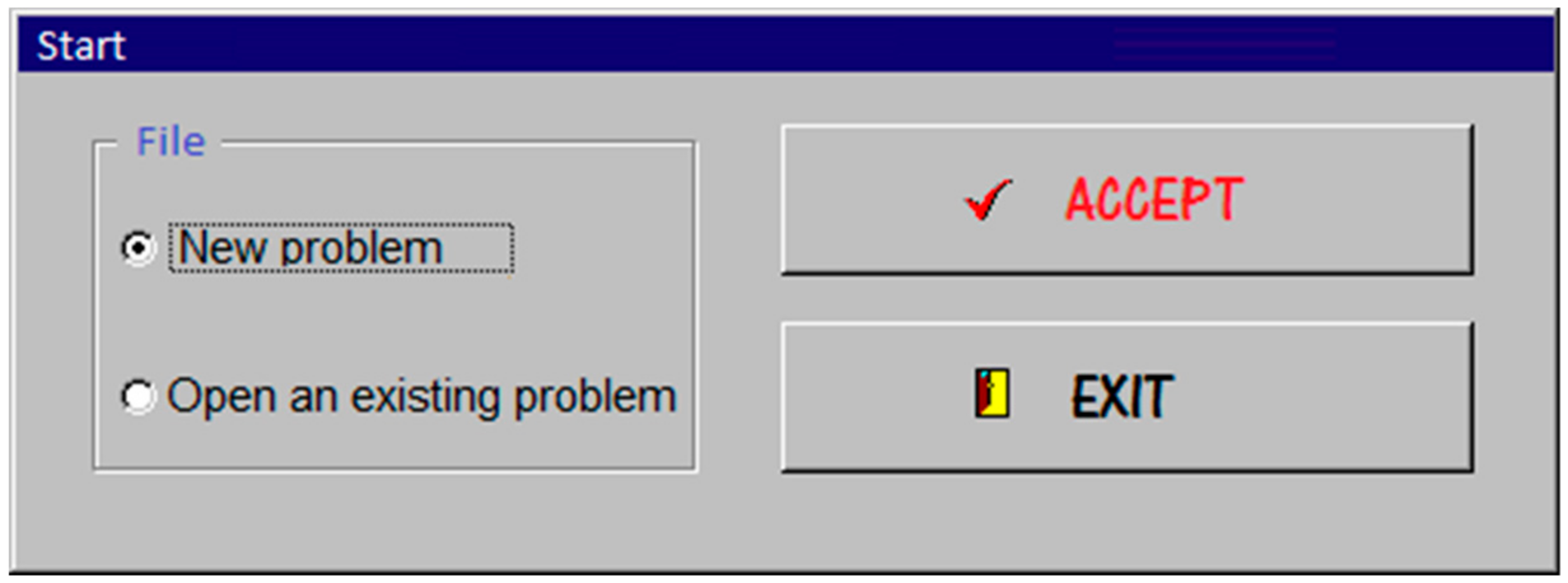
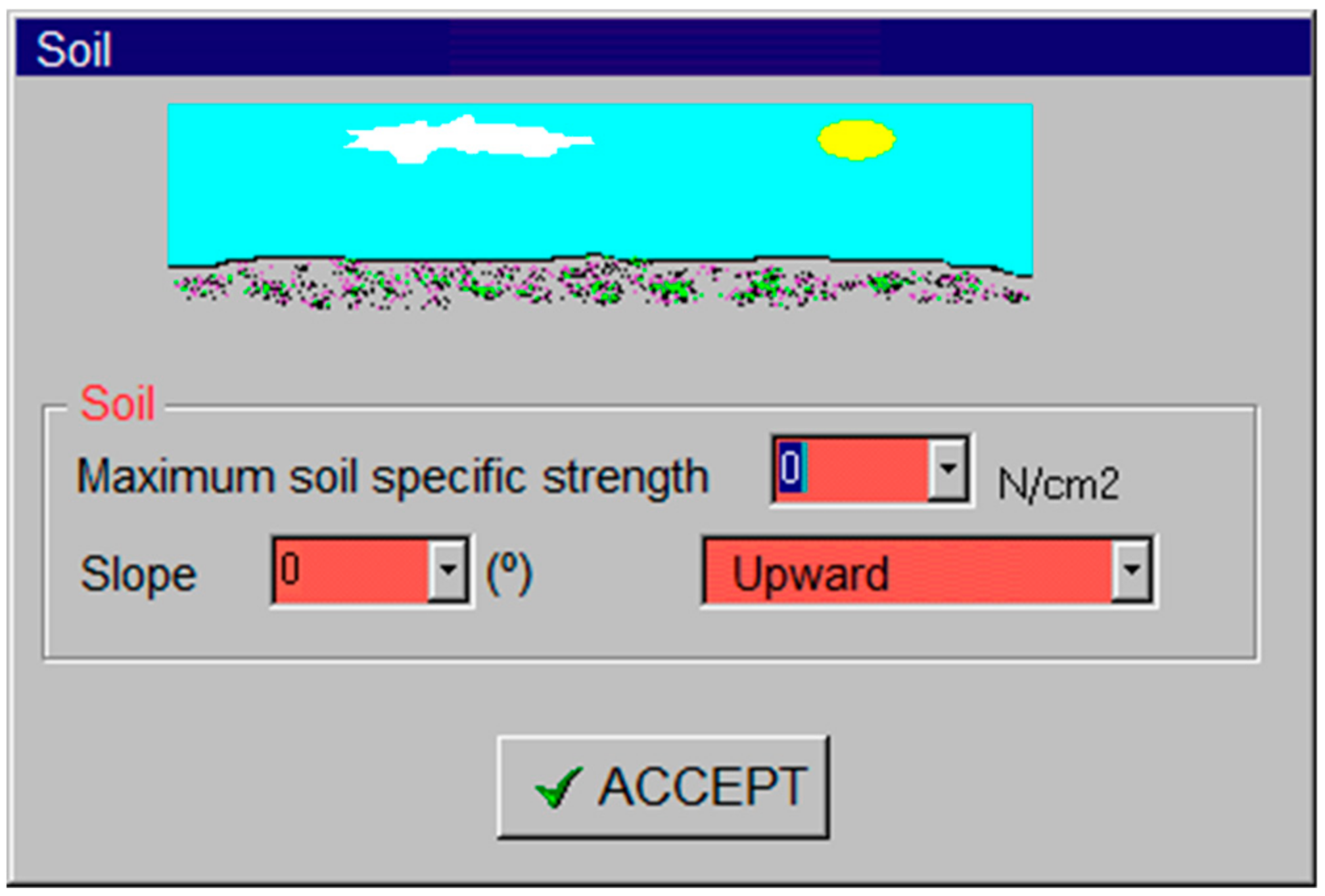
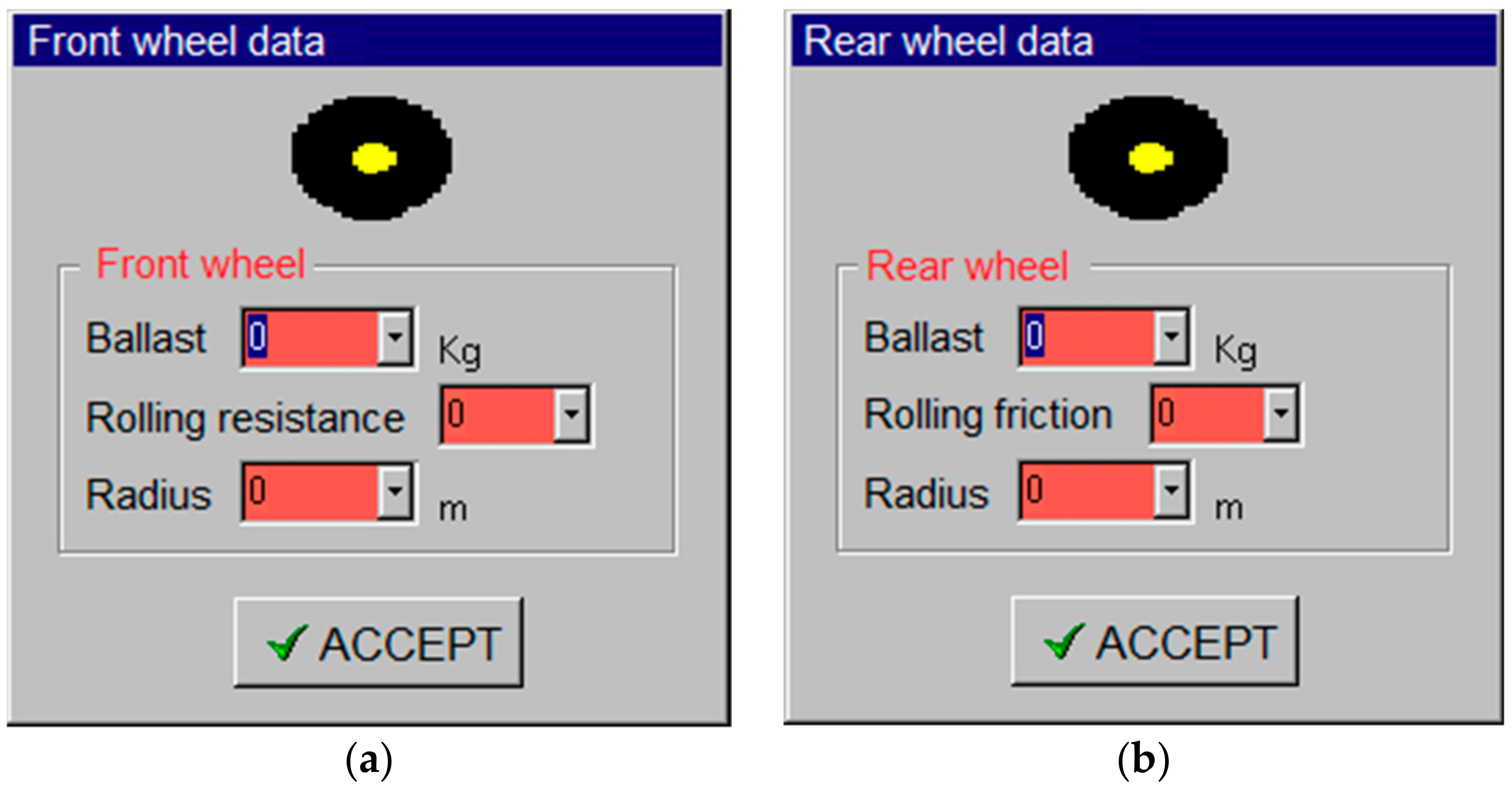
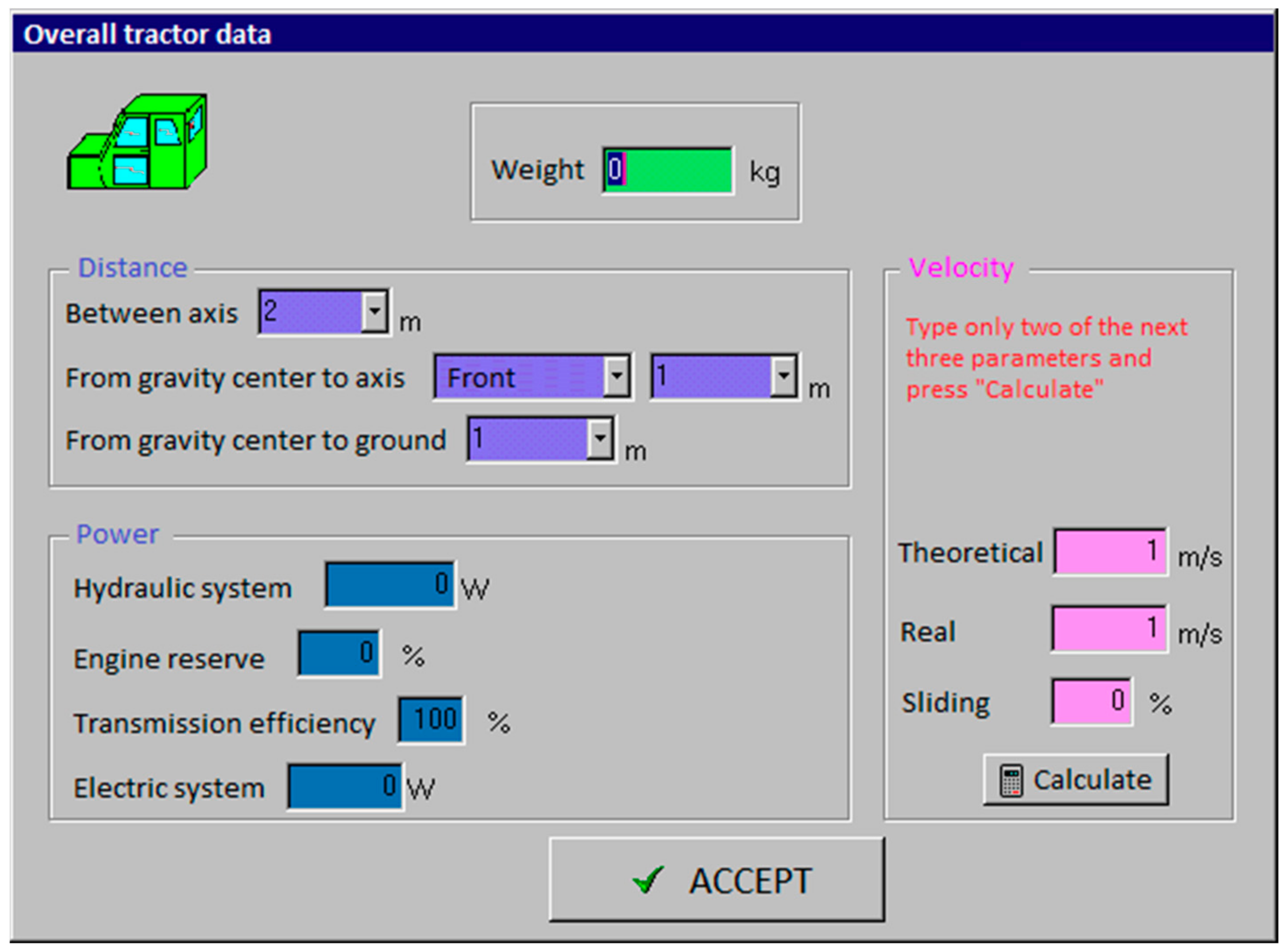
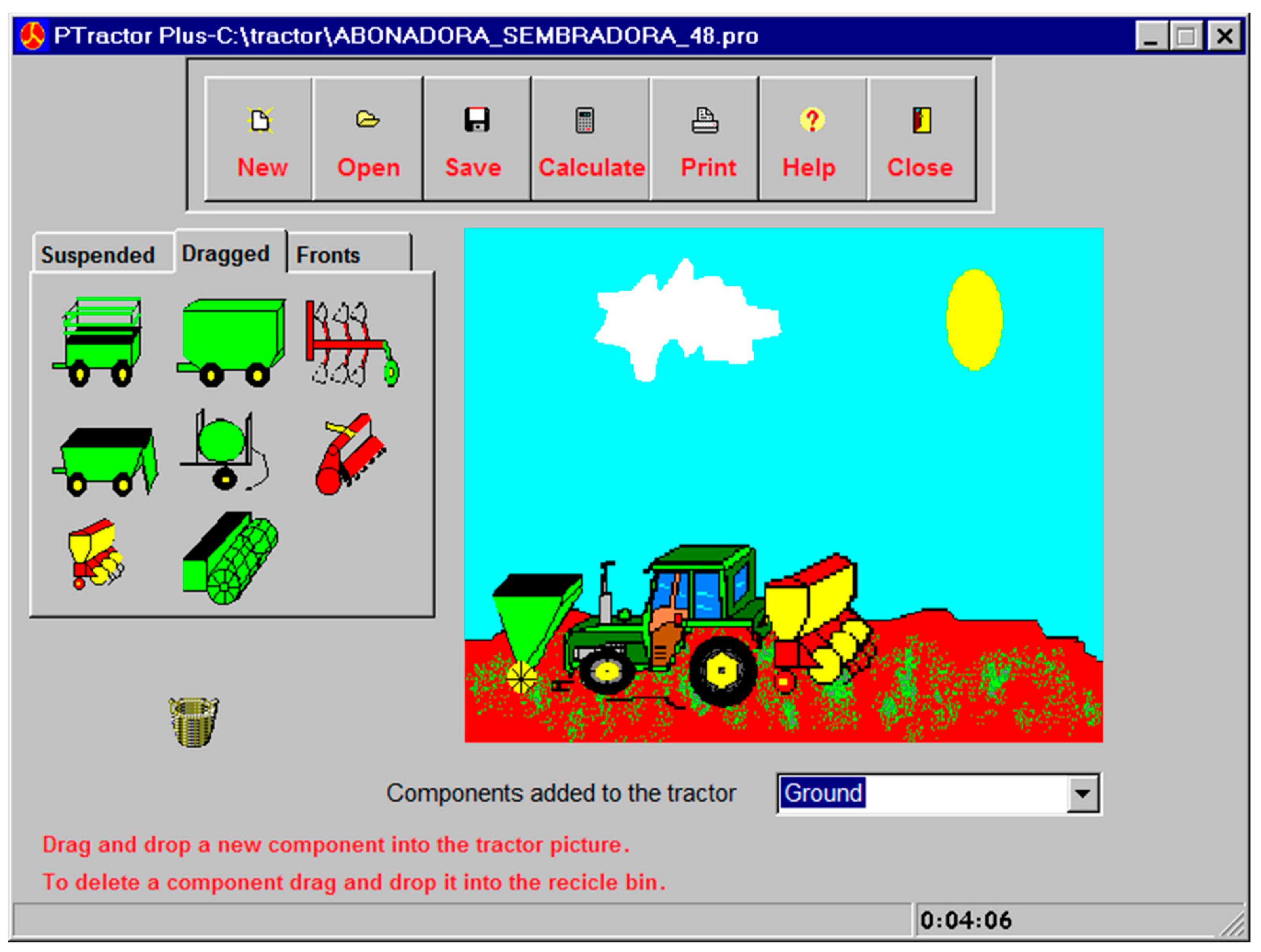

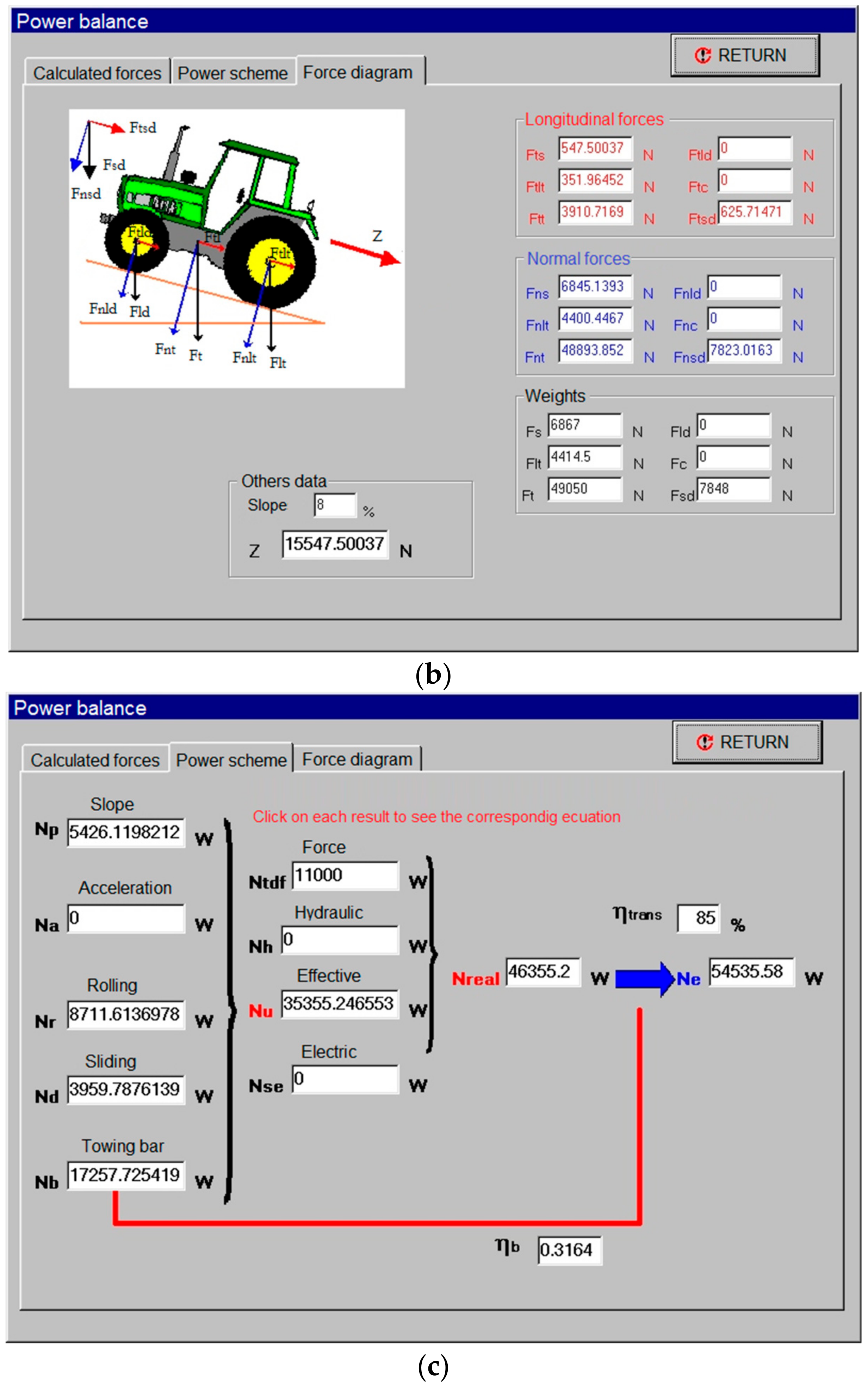
| Symbol | Magnitude | Symbol | Magnitude |
|---|---|---|---|
| Ne | Effective power of the engine | p | Pressure in the hydraulic system |
| NT | Power transmitted | q | Hydraulic flow |
| ηm | Mechanical yield of the transmission | ηg | Overall pump performance |
| Ns.e. | Power consumed by the electrical system | T | Moment of the power take-off system |
| Nh | Power consumed by the hydraulic system | ω | Velocity of power take-off |
| Nt.d.f. | Power supplied by the power take-off system | U | Peripheral forces in drive wheels |
| NU | Usable power | R | Resistance to movement |
| Nρ | Power losses in movement | Vt | Theoretical velocity |
| Nα | Power associated with the slope | VR | True velocity |
| Na | Power associated with acceleration | PT | Cross-sectional weight of the system |
| Nσ | Power lost due to sliding | Fi | Inertia of acceleration |
| NZ | Power transferred to the towing bar | Z | Force associated with the towing bar |
| V | Volt | I | Ampere |
| ηb | Bar yield (Z) |
| Variable | Category | Abbreviation |
|---|---|---|
| Students | ||
| 1. Sex | Male | Mal |
| Female | Fem | |
| 2. Age | ≤20 years old | T1 |
| ≥21 years old | T2 | |
| Software | ||
| 3. Is the interface easy to use? | Yes | q3y |
| No | q3n | |
| Ever | q3e | |
| 4. Would it improve the interface (titles, windows, menus, icons, buttons or figures)? | Yes | q4y |
| No | q4n | |
| Ever | q4e | |
| 5. Do you find useful the software to solve problems of power balances in tractors? | Yes | q5y |
| No | q5n | |
| Ever | q5e | |
| 6. Is the level of knowledge required to use the software in accordance with the academic level? | Yes | q6y |
| No | q6n | |
| Ever | q6e | |
| 7. Is the speed of response of the software correct? (user interaction and program) | Yes | q7y |
| No | q7n | |
| Ever | q7e | |
| 8. Do you think necessary previous explanations of the teacher in the classroom for the use of the software? | Yes | q8y |
| No | q8n | |
| Ever | q8e | |
| 9. Is it easy to navigate the program? | Yes | q9y |
| No | q9n | |
| Ever | q9e | |
| 10. Is the information correct and updated? | Yes | q10y |
| No | q10n | |
| Ever | q10e | |
| 11. Rate the software PTractor Plus 1.1. from 1 to 10: | <5 | L |
| 5–7 | M | |
| >7 | H |
| Variable | Categories | Frequencies | % |
|---|---|---|---|
| Age | T1 * | 9 | 56.25 |
| T2 | 7 | 43.75 | |
| Sex | Fem | 5 | 31.25 |
| Mal * | 11 | 68.75 | |
| q3 | q3e | 1 | 6.25 |
| q3y * | 15 | 93.75 | |
| q4 | q4e | 5 | 31.25 |
| q4n | 4 | 25.00 | |
| q4y * | 7 | 43.75 | |
| q5 | q5e | 1 | 6.25 |
| q5y * | 15 | 93.75 | |
| q6 | q6e | 3 | 18.75 |
| q6n | 3 | 18.75 | |
| q6y * | 10 | 62.50 | |
| q7 | q7e | 1 | 6.25 |
| q7y * | 15 | 93.75 | |
| q8 | q8e * | 7 | 43.75 |
| q8n | 4 | 25.00 | |
| q8y | 5 | 31.25 | |
| q9 | q9e | 5 | 31.25 |
| q9y * | 11 | 68.75 | |
| q10 | q10e | 3 | 18.75 |
| q10y * | 13 | 81.25 | |
| q11 | H * | 7 | 43.75 |
| L | 2 | 12.50 | |
| M * | 7 | 43.75 |
© 2018 by the authors. Licensee MDPI, Basel, Switzerland. This article is an open access article distributed under the terms and conditions of the Creative Commons Attribution (CC BY) license (http://creativecommons.org/licenses/by/4.0/).
Share and Cite
Gómez-Galán, M.; Carreño-Ortega, Á.; López-Martínez, J.; Callejón-Ferre, Á.-J. Solving Power Balance Problems in Single-Traction Tractors Using PTractor Plus 1.1, a Possible Learning Aid for Students of Agricultural Engineering. Educ. Sci. 2018, 8, 68. https://doi.org/10.3390/educsci8020068
Gómez-Galán M, Carreño-Ortega Á, López-Martínez J, Callejón-Ferre Á-J. Solving Power Balance Problems in Single-Traction Tractors Using PTractor Plus 1.1, a Possible Learning Aid for Students of Agricultural Engineering. Education Sciences. 2018; 8(2):68. https://doi.org/10.3390/educsci8020068
Chicago/Turabian StyleGómez-Galán, Marta, Ángel Carreño-Ortega, Javier López-Martínez, and Ángel-Jesús Callejón-Ferre. 2018. "Solving Power Balance Problems in Single-Traction Tractors Using PTractor Plus 1.1, a Possible Learning Aid for Students of Agricultural Engineering" Education Sciences 8, no. 2: 68. https://doi.org/10.3390/educsci8020068
APA StyleGómez-Galán, M., Carreño-Ortega, Á., López-Martínez, J., & Callejón-Ferre, Á.-J. (2018). Solving Power Balance Problems in Single-Traction Tractors Using PTractor Plus 1.1, a Possible Learning Aid for Students of Agricultural Engineering. Education Sciences, 8(2), 68. https://doi.org/10.3390/educsci8020068





